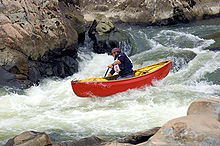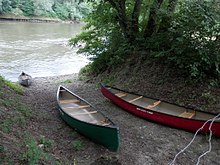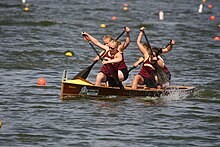Canadian
A Canadian (also Canadier ) is a mostly open canoe that is driven sitting or kneeling and moved with paddle paddles . Originally it was used by the North American Indians as a means of transport in the densely forested and impassable areas of North America, later the voyageurs used these boats for the purpose of fur trade to cover long distances with a lot of luggage.
Canadians and kayaks are the two main subsets of canoes.
In the English-speaking areas of the US and Canada, Canadians are known as canoe (also open canoe ). The homonymous transfer to Kanu has led to the fact that in the German language the term Kanu is not only a generic term for "kayak" and "Canadians" in sport, but also occasionally the Canadians as "Canoe Canadian Indians" or a this similar boat or a dugout canoe.
Material and construction
Canadians were first sewn by North American Indians from birch bark, and later in " Wood and Canvas " built covered wooden construction method with impregnated canvas. Today wood is also used in the form of waterproof glued plywood for inexpensive self-made canoes. After the end of the Second World War, countless Canadians were made of aluminum , which individual manufacturers still produce today. In the meantime, plastic in various variants has established itself as the dominant material, but has not completely replaced any of the other materials. The choice of material is influenced by aspects of robustness, aesthetics and weight.
In addition to these fixed-construction boats, there are also folding canoes and inflatable canoes .
Canadians are typically symmetrically built open boats with two pointed ends. “Front” and “rear” are not defined by the shape, but only by the position of the seats: the rear seat is closer to the rear tip of the boat than the front seat is at the front tip.
Unbalanced Canadians are heavily influenced by their intended use. The asymmetry can consist of peaks of different heights, or in a forward or backward shifted position of the greatest trunk width. Some canoes have an engine mirror at the stern.
Canadians without a curvature of the keel line (called " keel jump " ) or even with a shaped keel have a pronounced directional stability and are therefore more suitable for open waters. Those with a stronger keel are more manoeuvrable and are preferably used in running waters through to whitewater.
Traditionally, Canadians are equipped with benches. White water boats have seat blocks attached to the keel line, so-called "saddles" . The saddles have belt loops on the front side and a stretcher board at the back. The paddler sits astride the saddle, puts his knees in the loops and supports himself with the tips of his feet on the stretcher. This allows him to cling to the boat and achieve close boat contact. In the event of capsizing, this enables the skilled paddler to use a capsize roll similar to the Eskimo roll . If necessary, the paddler can quickly and easily detach himself from the Canadian by taking his feet off the stretcher and sliding backwards out of the loops.
Canadians who practice freestyle or Canadian style often have no built-in seat at all. Sit'n'switch is the technique used by marathon paddlers to quickly move their boat forward while frequently changing sides.
Parts of a Canadian
- Bug
- Rear
- hull
- Seat
- Holm ( Ducht ) (a horizontal cross member at the top of the trunk)
- Coaming rim / gunwale
- Buoyancy aid that prevents the canoe from sinking after capsizing.
Some Canadians, e.g. B. for portages , a centrally placed support yoke . The yoke is usually built in as a ducht. In some cases, however, there are also removable support yokes in order to be able to optimally arrange the seat of solo canoes in relation to the boat's center of gravity. With Tumplines as additional equipment, much of the Canadian's weight can be transferred from the shoulders to the wearer's forehead.
Traditional use
Wandering canadians are often used for canoeing on lakes or calm rivers. They hold a lot of luggage and - depending on the design - can accommodate several people. That's why families like to use them. There are also Canadians in solo construction that can be paddled by one person. Different paddling techniques allow paddling without changing sides while avoiding yawing of the boat or changing sides quickly after a few paddling strokes ( sit'n'switch technique ).
Canadians are preferably built to be lightweight to allow rapids or other obstacles to be avoided by being carried over portages . Canadians are characterized by a shallow draft, which makes the boat very manoeuvrable and can also navigate shallow waters. The wide construction in the middle of the boat ensures a high level of protection against capsizing.
The forerunners of today's Canadians were used by the Indians of North America for transport, hunting and fishing. They could take heavy loads and thus support the nomadic way of life of their inventors. Classic Native American Canadians were up to 10 meters long. These great Canadians were also used to transport goods and animals. Travel Canadians could even be sailed. The Canadians of the voyageurs were sometimes even longer. Some of these war canoes ( war canoes ) could also be divided for better overland transport.
Canadians are traditionally moved forward with paddles in a kneeling position. Today's recreational hiking Canadians are often paddled seated . From New England comes the technique of Canoe-pole at the Canadian standing with a Stakstange, mostly upriver like a punt will be promoted. So-called “pack canoes” are pushed forward sitting deep in the boat like kayaks with double paddles . They are comparatively small and extremely light, so that they can also be used on narrow waterways.
The classic Canadians are open-topped canoes with plenty of space for luggage and people. Other types of construction are also available in closed form, especially for white water . Whitewater canoes or hiking canoes on fast flowing waters are usually equipped with inflatable buoyancy devices that ensure that a capsized boat floats high.

Competitive sport
The Canadian is a piece of sports equipment in canoe racing , canoe slalom , canoe freestyle , canoe marathon and white water descent . Dragon boats and rafts are basically moved like Canadians and z. T. also counted in this category. The first two disciplines mentioned are Olympic , in all of the aforementioned areas there are German championships and world championships.
Canadians in canoe racing are lightweight and difficult to control sports equipment. A single (C1) is up to 5.20 m long and around 40 cm wide and offers just enough space to kneel in. The typical posture in the boat is a position in which the front leg is placed in the boat and the back leg is kneeled in the boat. The boat is propelled with a single blade (paddle) on only one side. It is controlled by turning in the blade at the end of the “stroke”, called the “control stroke” (pulling the blade along the boat is so called). In two-man (C2), four-man (C4) and eight-man (C8), half of the athletes usually paddle on the right and left side.
The German Canoe Association decided in 1920 to classify canoes into kayaks ("K") and "Canadier" ("C"). This subdivision is still valid today and is the main reason why the spelling with "C" has prevailed in the competition disciplines.
Up until 2010, Canadian competition in Europe (with the exception of C2 mixed in canoe slalom and white water racing) was, in contrast to North America, a purely man's business. Now recognized by the ICF (International Canoe Federation), competitions for women have also been held in the Canadian disciplines.
Recreational sports
Especially in Germany, where hiking on rivers ( canoeing ) has a long tradition, the Canadian is a popular hiking and leisure boat for families. Today's hiking canadians are suitable for tours on lakes or calmer rivers with luggage and with several people. There are also boats that are suitable for fast flowing waters and even white water (WW IV). Entry into this leisure sport is mostly done individually or in a club .
- Knee seat for comfortable water hikes
Individual evidence
See also
Web links
- Forum of German Canoeists http://www.open-canoe-journal.de/
- The Open Canoe Group http://www.open-canoe.de/
- Canadier by Ralf Schönfeld http://www.kanadier.gps-info.de/
- German Open Canoe http://www.goc.de/
- Swiss Open Canoe http://www.soc.ch
- German Canoe Association http://www.kanu.de







